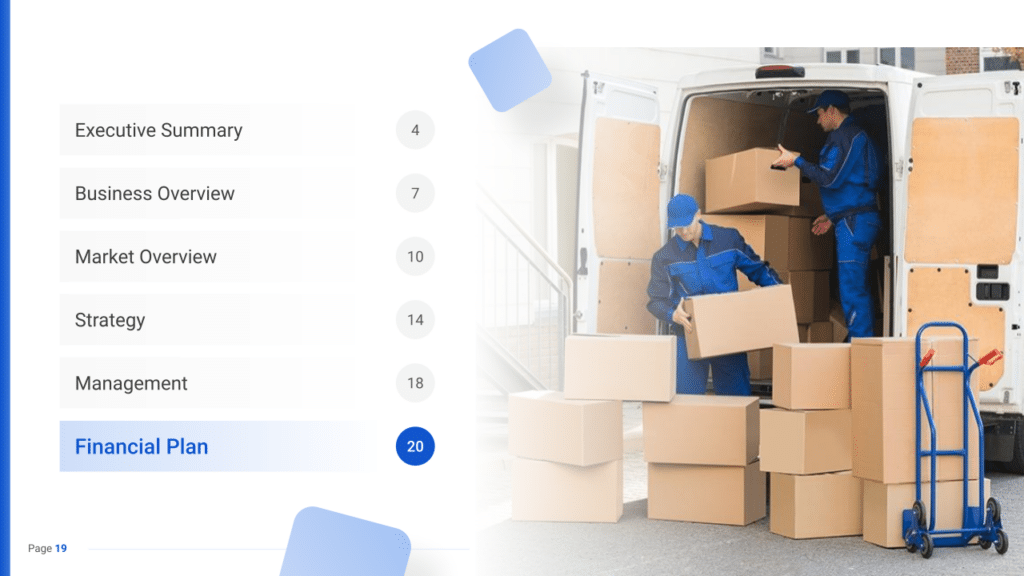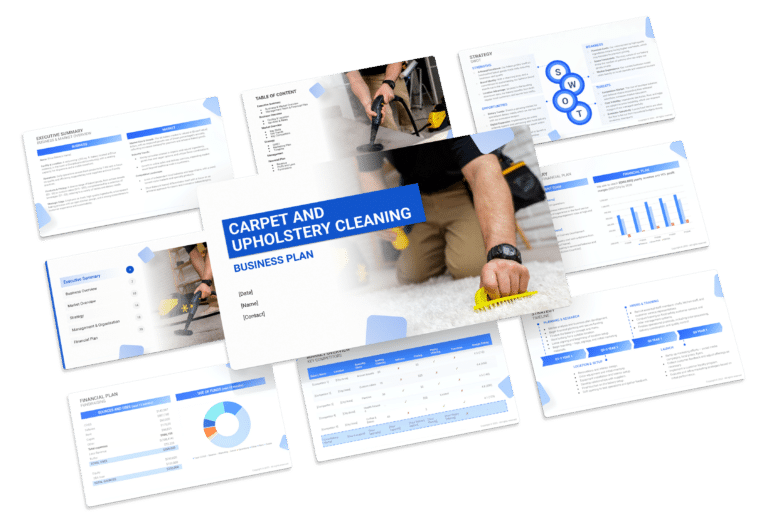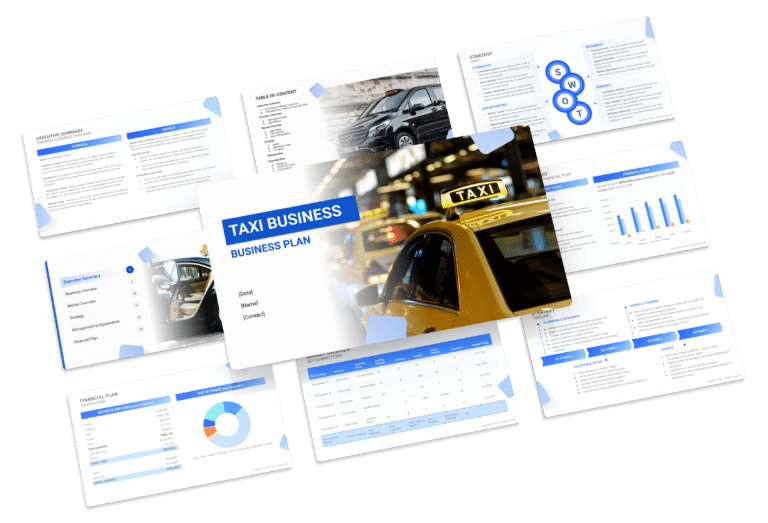Moving Business Plan Template & PDF Example
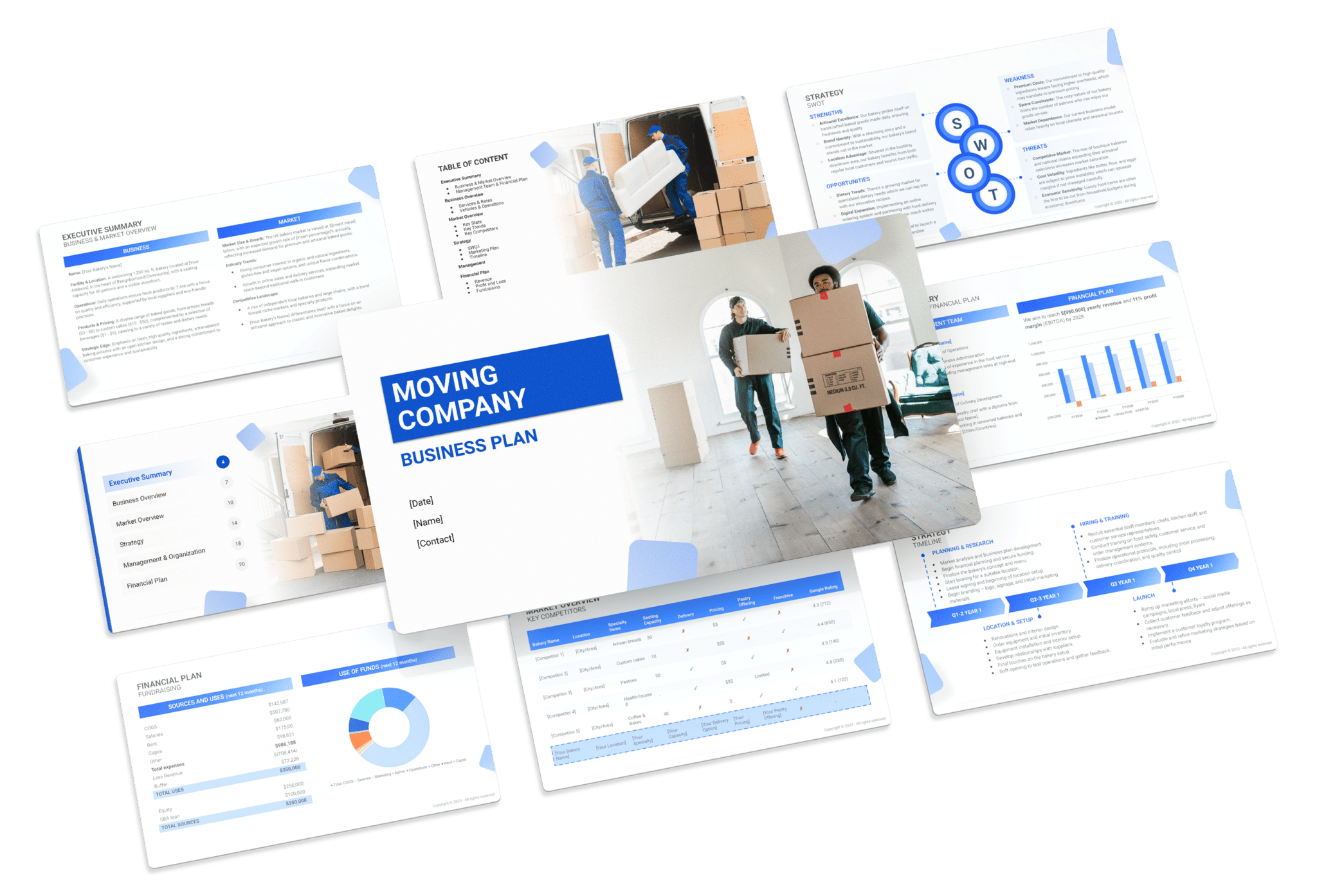
Creating a comprehensive business plan is crucial for launching and running a successful moving business. This plan serves as your roadmap, detailing your vision, operational strategies, and financial plan. It helps establish your moving business’s identity, navigate the competitive market, and secure funding for growth.
This article not only breaks down the critical components of a moving business plan, but also provides an example of a business plan to help you craft your own.
Whether you’re an experienced entrepreneur or new to the service industry, this guide, complete with a business plan example, lays the groundwork for turning your moving business concept into reality. Let’s dive in!
The Plan
Our moving company business plan is designed to cover all critical facets necessary for a comprehensive and strategic outline. It details the company’s operational strategies, marketing initiatives, market conditions, competitive analysis, management team, and financial projections.
- Executive Summary: Offers a brief overview of the moving company’s business concept, highlighting the market analysis, management team expertise, and financial strategy.
- Business Overview: This section delves into the specifics of the moving company’s operational framework and services:
- Operations: Discusses the geographic areas served by the company, the fleet of vehicles used for moving services, and the warehouse facilities for storage solutions.
- Services & Rates: Outlines the variety of moving services offered, including local and long-distance moves, along with a detailed pricing model based on hourly rates for local moves and price per mile for long-distance moves.
- Market Overview: Provides an analysis of the moving industry landscape, positioning the company within the competitive market:
- Key Stats: Shares insights on the size of the moving industry, the number of moving companies, and the average number of Americans moving annually.
- Key Trends: Highlights significant trends affecting the moving industry, such as demographic characteristics of movers, reasons for moving, and changes in homeownership and rental trends.
- Key Competitors: Evaluates major competitors in the market, comparing services, geographic coverage, and customer reviews.
- Strategy: Outlines the strategic approach for achieving business growth and securing a competitive edge:
- SWOT Analysis: A thorough evaluation of the company’s strengths, weaknesses, opportunities, and threats.
- Marketing Plan: Details the marketing strategies to promote the moving services, including digital marketing, partnerships, and direct consumer outreach.
- Timeline: Sets forth key milestones and objectives for the moving company from inception through the first year and beyond.
- Management: Provides information on the moving company’s management team, detailing their backgrounds, roles, and contributions to the company’s success.
- Financial Plan: Projects the financial performance of the moving company over the next five years, including revenue forecasts, profit and loss statements, and the financial strategy for achieving profitability and growth.

Executive Summary
The Executive Summary introduces your moving business’s plan, offering a concise overview of your company and its services. It should detail your market positioning, the range of moving and relocation services you offer, its location, fleet size, and an outline of day-to-day operations.
This section should also explore how your moving business will integrate into the local market, including the number of direct competitors within the area, identifying who they are, along with your company’s unique selling points that differentiate it from these competitors.
Furthermore, you should include information about the management and co-founding team, detailing their roles and contributions to the company’s success.
Additionally, a summary of your financial projections, including revenue and profits over the next five years, should be presented here to provide a clear picture of your moving business’s financial plan.
Moving Business Plan Executive Summary Example
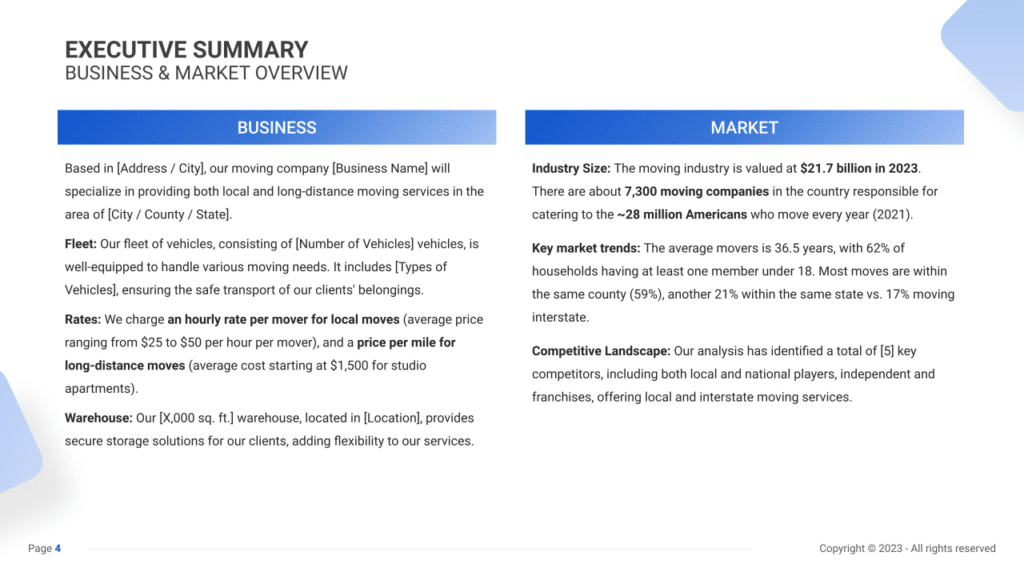
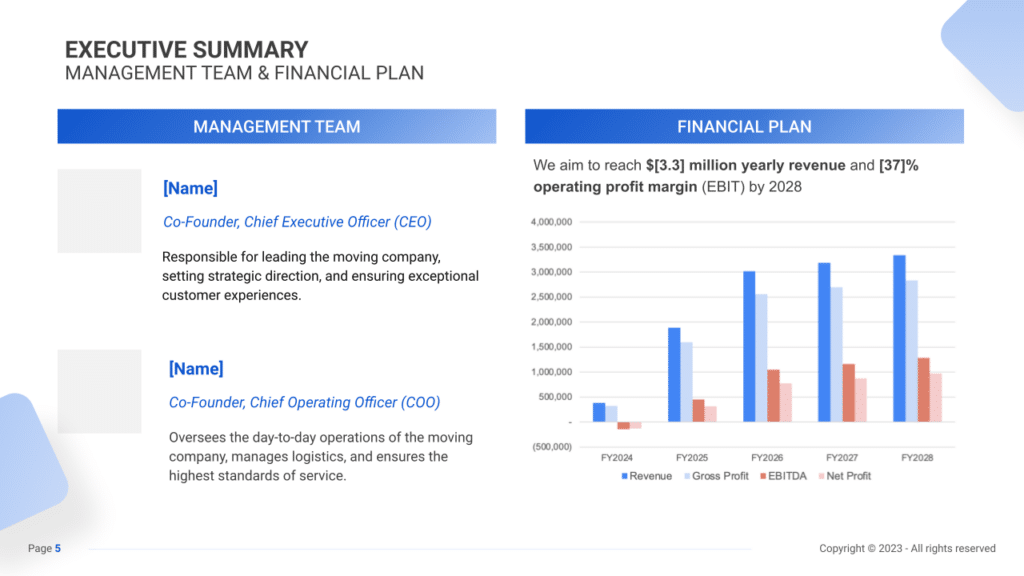
Business Overview
In the business overview, provide a succinct summary of your moving company, including its name, location, and a brief on the day-to-day operations. This section sets the stage for highlighting your business’s unique aspects.
Your Unique Selling Proposition (USP) is what distinguishes your moving company from the competitors. It could be your specialized moving services, exceptional customer care, or innovative logistics solutions. Your USP should be a centerpiece of the executive summary, drawing in your audience and underscoring the unique value your business offers.
Example:
“RelocateMe Moving Services,” headquartered in downtown Anytown, operates with a fleet of 10 state-of-the-art moving vehicles, offering both local and long-distance moves. What sets RelocateMe apart is their commitment to eco-friendly moving solutions and unmatched customer service, ensuring a stress-free moving experience for all clients.
Market Overview
This part should illuminate the size, trends, and dynamics of the moving industry, supported by relevant data such as market valuation and growth rates. Highlighting industry trends, like the increasing demand for eco-friendly moving solutions or technological innovations in logistics, can provide insights into the market’s direction and your company’s place within it.
Discussing the competitive landscape is also crucial. Here, identify your main competitors and articulate how your company stands out. This could be through specialized services, competitive pricing, or superior customer experience.
Example:
RelocateMe is positioned in the $21.7 billion moving industry, navigating through a market with a considerable number of yearly relocations. Despite the competition, RelocateMe distinguishes itself by offering green moving solutions and advanced booking technologies, appealing to the environmentally conscious and tech-savvy segment of movers.
Management Team
Your management team’s expertise is a significant asset to your business. Highlight the key qualifications and experiences of your team members, showcasing the depth of knowledge and leadership within your company.
Example:
RelocateMe is spearheaded by founders Alex Taylor and Jamie Rivera. Alex, with over 20 years in logistics and supply chain management, and Jamie, a customer service expert with a knack for operational efficiency, bring a blend of industry knowledge and customer-centric focus to the table, setting RelocateMe up for success.
Financial Plan
Summarize your financial objectives and forecasts here, including revenue targets and profit margins. This overview should offer a clear view of your company’s financial future.
Example:
RelocateMe projects an annual revenue of $3.3 million by year five, with an operating profit margin of 37%. The financial strategy focuses on leveraging efficient moving solutions and expanding service offerings to drive growth and profitability.
Business Overview
For a moving business, the Business Overview section can be concisely divided into 2 main slides:
Operations
Briefly describe your moving company’s operational capabilities, focusing on the efficiency and reliability of your services. Mention the size and variety of your fleet, including vans, trucks, and any specialized moving equipment, to cater to different client needs.
Highlight the strategic location of your headquarters or depots, emphasizing accessibility for clients and ease of reaching various parts of the city or region. Explain why this operational setup is advantageous in providing prompt and flexible moving services to your target clientele.
Services & Rates
Detail the range of moving and relocation services offered, from residential moves and office relocations to specialized services like piano or art moving.
Outline your pricing strategy, ensuring it reflects the value and complexity of the services provided and matches the market you’re targeting. Highlight any bundled services, seasonal discounts, or loyalty programs that provide added value to your clients, encouraging repeat business and customer loyalty.
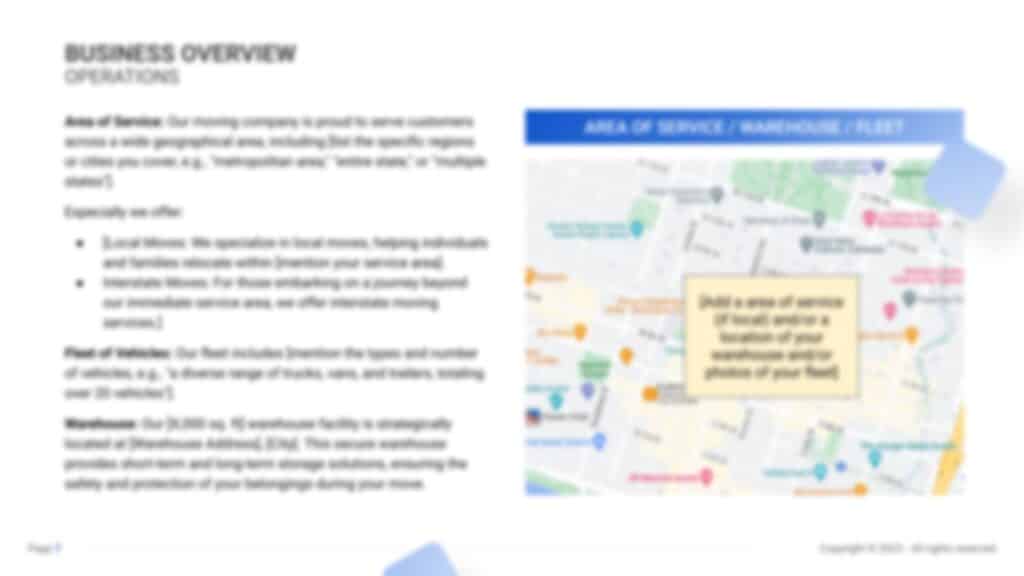
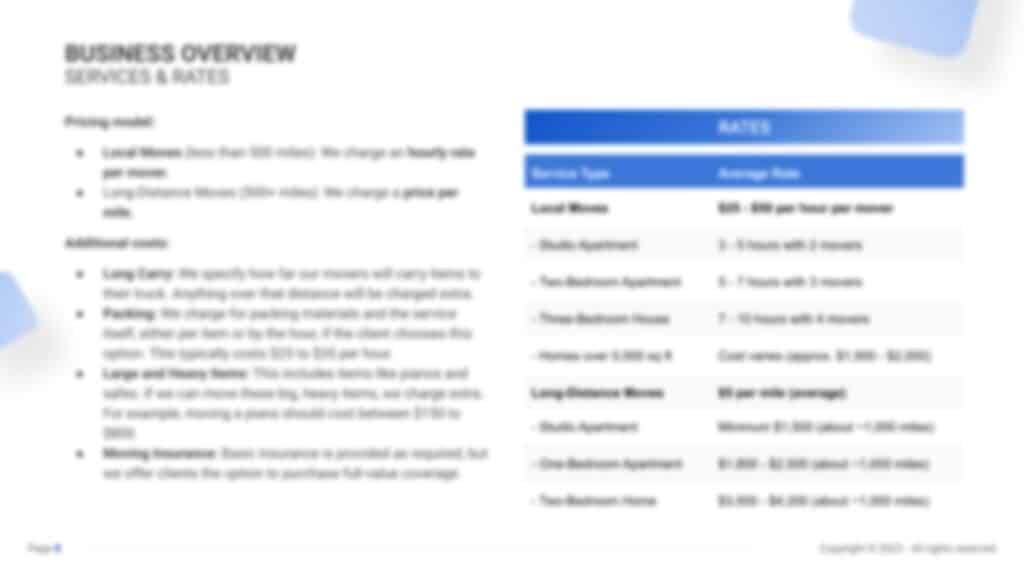
Market Overview
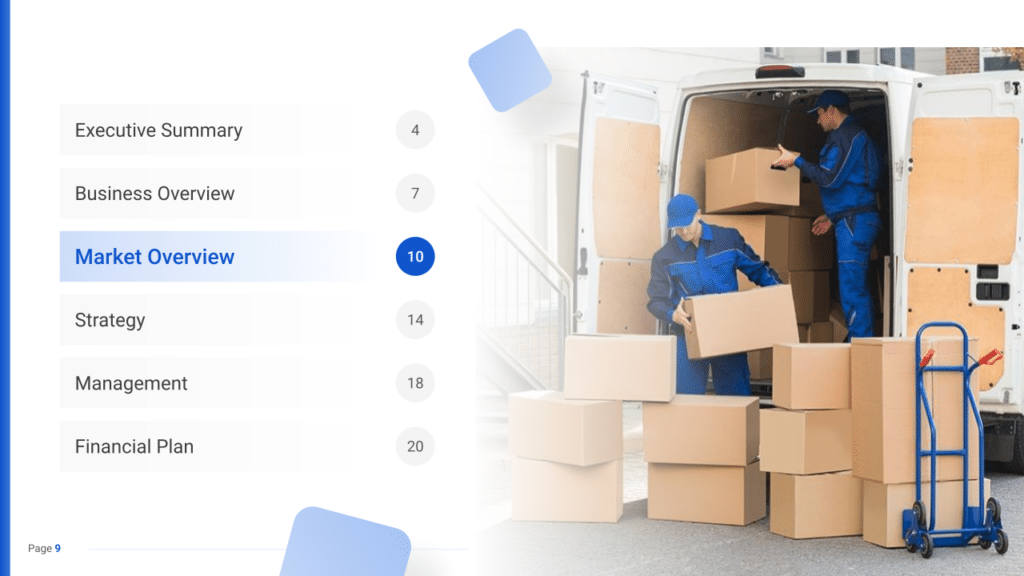
Industry Size & Growth
In the Market Overview of your moving business plan, start by examining the size of the moving industry and its growth potential. This analysis is crucial for understanding the market’s scope and identifying expansion opportunities.
Key Market Trends
Discuss recent market trends, such as the increasing consumer demand for seamless moving experiences, the need for specialized moving services, and the adoption of technology in moving processes. Highlight the growing interest in services tailored to unique moving requirements and the preference for eco-friendly moving practices.
Competitive Landscape
A competitive analysis is not just a tool for gauging the position of your moving business in the market and its key competitors; it’s also a fundamental component of your business plan. This analysis helps in identifying your moving business’s unique selling points, essential for differentiating your business in a competitive market.
In addition, the competitive analysis is integral in laying a solid foundation for your business plan. By examining various operational aspects of your competitors, you gain valuable information that ensures your business plan is robust, informed, and tailored to succeed in the current market environment.
Identifying Your Competitors in the Moving Industry
The first step in a competitive analysis for a moving business is to identify your direct and indirect competitors. Map out local moving companies, both large and small, offering services in your target area. For instance, if your moving business specializes in residential moves, your direct competitors might include established local moving companies known for their reliable and efficient residential services. Indirect competitors could include self-service storage facilities or DIY moving truck rental services.
Utilize online tools such as Google Maps to visually understand the distribution of competitors. Platforms like Yelp and Better Business Bureau can provide customer reviews, giving you insights into your competitors’ strengths and weaknesses. If “Swift Movers” is consistently praised for their punctuality and careful handling of items, these aspects become crucial competitive factors.

Moving Business Competitors’ Strategies
Analyzing the strategies of your moving competitors involves several key aspects:
- Service Offerings: Examine the range of services your competitors provide. If a competitor like “Efficient Moves” is gaining popularity for their specialty in office relocation, it signals a potential market demand for specialized moving services.
- Logistics and Equipment: Consider the logistics and equipment used by competitors. A company like “Rapid Relocations” that invests in advanced tracking systems and modern moving equipment may appeal to customers looking for a high-tech, efficient moving experience.
- Pricing Structure: Compare your pricing structure with competitors. Are you positioning your moving services as budget-friendly like “Affordable Moves,” or are you aligning your pricing with premium services offered by “Elite Movers”?
- Marketing Tactics: Evaluate how competitors market their moving services. Do they leverage digital marketing and online platforms, or do they rely on traditional methods and local partnerships?
- Customer Experience: Assess the overall customer experience provided by competitors. If “Friendly Haulers” is known for its courteous staff and excellent customer service, this becomes a competitive advantage to be aware of.
- Operational Efficiency: Observe if competitors are embracing technological advancements or innovative processes to enhance operational efficiency. For instance, a company like “Tech Transitions” might stand out with its user-friendly online booking system and real-time tracking.
What’s Your Moving Business’s Value Proposition?
Reflect on your moving business’s unique value proposition. Perhaps your company is distinguished by its focus on eco-friendly moving practices, or you offer specialized services for fragile and valuable items, filling a niche in the market.
Identify gaps in the market through customer feedback and industry trends. For example, if there is a growing demand for sustainable moving solutions and your competitors are not addressing this, it presents an opportunity for your business.
Consider your location and target audience. A moving business situated in a busy urban area might emphasize speed and efficiency, while one in a suburban setting may focus on personalized, family-oriented services.
Strategy
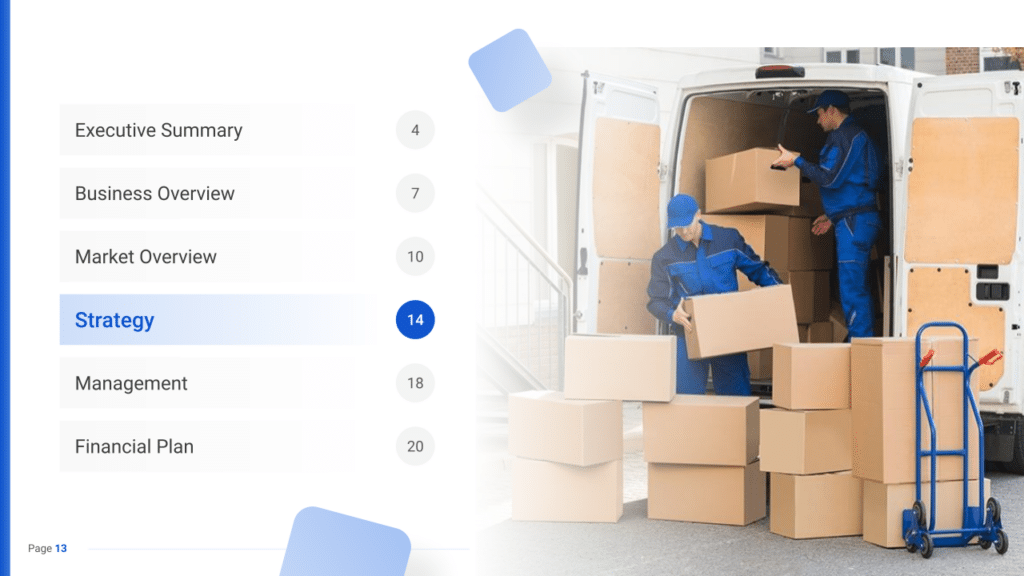
SWOT
First, conduct a SWOT analysis for the moving business, highlighting Strengths (such as a diverse fleet and comprehensive service offerings), Weaknesses (including potential logistical challenges or intense competition), Opportunities (for example, the growing demand for moving services due to housing market trends), and Threats (such as fuel price fluctuations that may impact operational costs).
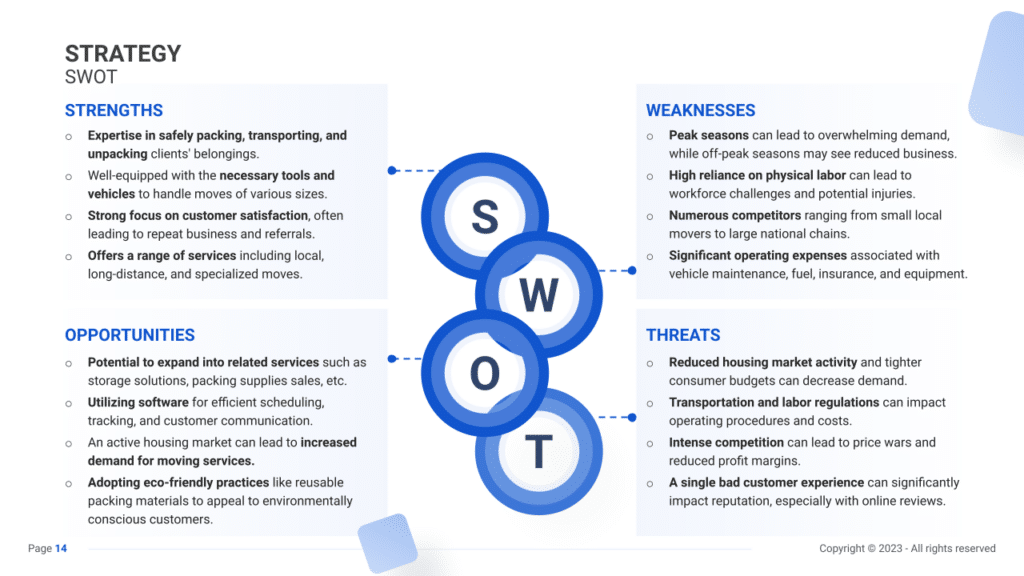
Marketing Plan
Next, develop a marketing strategy that outlines how to attract and retain customers through targeted advertising, competitive pricing, a strong online presence, and partnerships with real estate agencies.
Marketing Channels
Selecting the right marketing channels facilitates effective communication of your brand message and services to potential clients, thereby generating leads and fostering engagement.
Digital Marketing
- Website Development: A user-friendly and informative website serves as the cornerstone of your online presence. It should not only showcase your services but also prioritize user experience, providing easy navigation, clear service descriptions, testimonials, and a convenient quote request process.
- Leveraging Social Media: Engaging with potential customers on platforms such as LinkedIn, Facebook, and Instagram allows for targeted communication. Sharing success stories, client testimonials, and informative content, coupled with regular interactions and engagement, helps build trust and brand recognition.
- Content Marketing: Producing high-quality content, such as blog posts, videos, or infographics, that offers valuable insights into the moving process, tips for efficient packing, or guides to choosing the right moving service establishes your authority in the industry. It also helps in attracting organic traffic to your website through search engine optimization (SEO) strategies.
Local Advertising
- Listing in Local Directories: Ensuring your business is prominently listed in local directories and online platforms enhances visibility and accessibility for potential customers seeking moving services within your vicinity.
- Community Engagement: Active involvement in local events, sponsorships, or partnerships with community-centric organizations fosters a sense of belonging and trust within the community. Participating in neighborhood initiatives not only promotes your brand but also establishes your commitment to local welfare.
- Forge Strategic Partnerships: Collaborating with complementary local businesses, such as real estate agencies, storage facilities, or interior designers, can open avenues for referrals and joint promotional activities, expanding your customer reach.
Promotional Activities
- Seasonal Promotions and Discounts: Crafting compelling seasonal campaigns or targeted discounts, such as offering discounted rates for moves during off-peak seasons or exclusive packages for specific events (e.g., college relocations or corporate moves during peak business seasons), attracts clients during strategic times.
- Referral Programs: Encouraging existing clients to refer new customers by offering incentives or discounts for successful referrals cultivates a loyal customer base while expanding your clientele through word-of-mouth marketing.
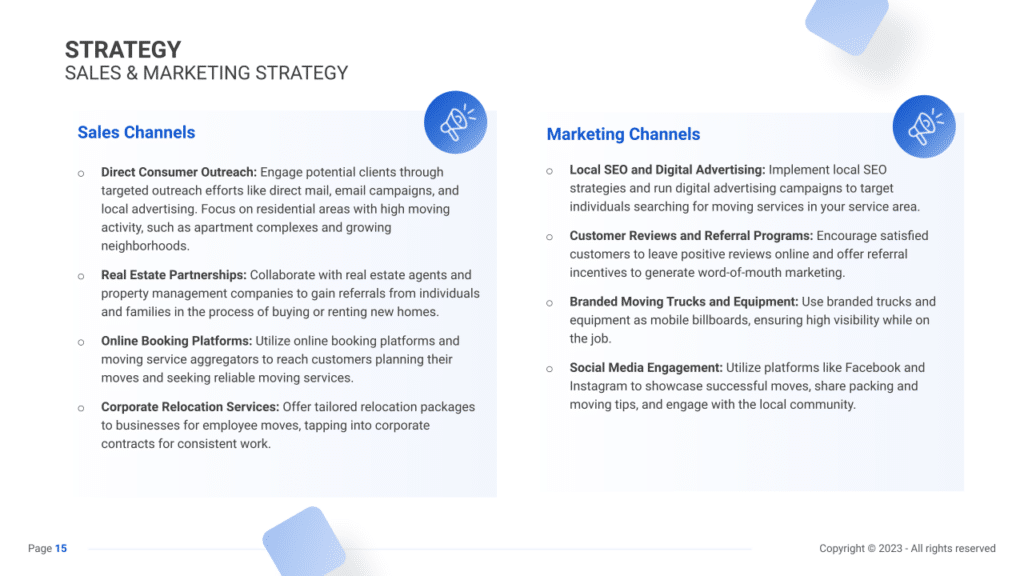
Sales Channels
Implementing effective sales strategies is vital for converting leads into paying customers and maximizing revenue opportunities.
Consultative Selling
- Personalized Service Offerings: Providing personalized consultation and tailored moving plans based on the client’s unique needs not only ensures customer satisfaction but also builds loyalty and increases the likelihood of repeat business and referrals.
- Transparent Pricing and Detailed Estimates: Offering transparent pricing models and comprehensive estimates instills confidence and trust in potential clients. Clear communication about costs and breakdowns helps clients make informed decisions.
Online Booking and Sales
- User-Friendly Booking Systems: Implementing intuitive and efficient online booking systems on your website streamlines the booking process for clients. Offering incentives or discounts for online bookings encourages customers to utilize this convenient option.
- Additional Services Upselling: Offering supplementary services, such as packing supplies, insurance options, or cleaning services, during the booking process maximizes upsell opportunities and enhances the overall customer experience.
Membership and Loyalty Programs
Encouraging repeat business through tailored membership and loyalty programs enhances customer retention and promotes brand advocacy.
Client Loyalty Programs
- Membership Options: Creating membership programs that offer exclusive benefits, such as discounted rates for recurring moves or access to priority scheduling, incentivizes customer loyalty.
- Loyalty Rewards: Implementing digital loyalty programs where clients earn points for every transaction, redeemable for discounts on future moves or additional services, fosters long-term relationships and repeat business.
Strategy Timeline
Finally, create a detailed timeline that outlines critical milestones for the moving business’s launch, marketing initiatives, customer base expansion, and growth objectives, ensuring the business advances with clear direction and purpose.

Management
The management section focuses on the moving business’s management and their direct roles in daily operations and strategic direction. This part is crucial for understanding who is responsible for making key decisions and driving the moving business toward its financial and operational goals.
For your moving business plan, list the core team members, their specific responsibilities, and how their expertise supports the business.
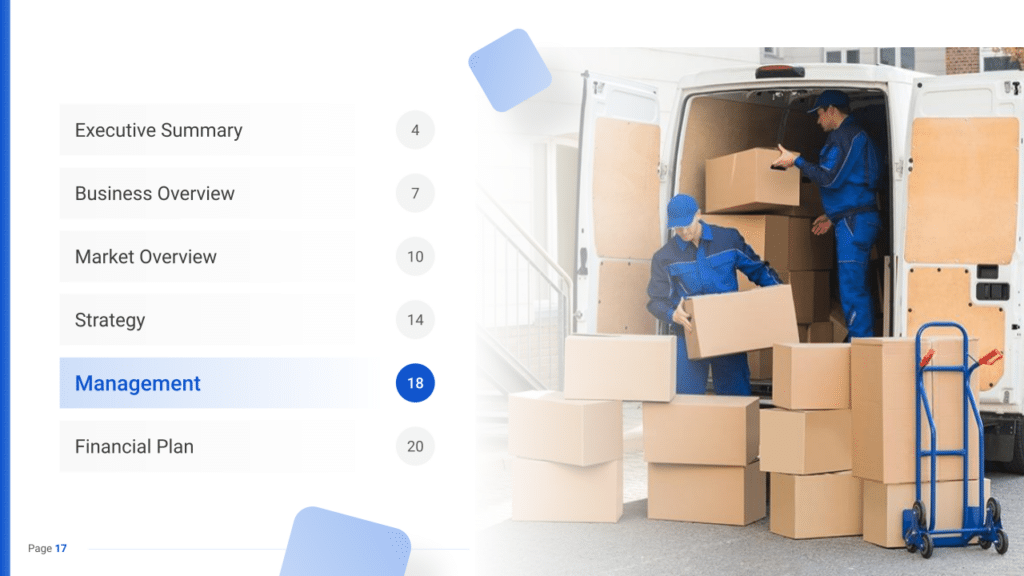

Financial Plan
The Financial Plan section is a comprehensive analysis of your financial projections for revenue, expenses, and profitability. It lays out your moving business’s approach to securing funding, managing cash flow, and achieving breakeven.
This section typically includes detailed forecasts for the first 5 years of operation, highlighting expected revenue, operating costs and capital expenditures.
For your moving business plan, provide a snapshot of your financial statement (profit and loss, balance sheet, cash flow statement), as well as your key assumptions (e.g. number of customers and prices, expenses, etc.).
Make sure to cover here
_ Profit and Loss
_ Cash Flow Statement
_ Balance Sheet
_ Use of Funds
